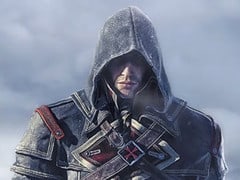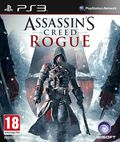You can trust VideoGamer. Our team of gaming experts spend hours testing and reviewing the latest games, to ensure you're reading the most comprehensive guide possible. Rest assured, all imagery and advice is unique and original. Check out how we test and review games here
Whisper it, but it’s very possible that Assassin’s Creed Rogue, the series’ forgotten last-gen stepchild that launches at the same time as Unity, will be the better game. Paris is, after all, not a coastal city.
Being a direct sequel to AC4: Black Flag, its focus is once again on naval gameplay, continuing every one of the previous game’s major concepts and features and setting things 20 years ahead, bridging the gap between AC4 and AC3 and cementing the already pretty solid links between them with loose ends being tied up at a rate of knots. Old characters pop-up, some for cameos, others as lynchpins of the story.
An old landscape returns in the form of New York, a younger Manhattan than the one seen in AC3, but beefed up a little and redesigned for easier traversal. The rest of the game is new, split into two distinct areas that are each roughly the size of AC4’s Caribbean. There’s a lot of game here, as you’d expect from a full-fat Assassin’s Creed title: it’s stuffed with missions, side-quests, things to upgrade, bits to explore, and so on.
Which is what makes its existence all the more absurd. This isn’t a smaller game releasing alongside a bigger one. It’s an honest-to-goodness proper sequel to AC4, and fans of that game should rejoice, because it retains all that was decent (and much that was rubbish, but you can’t have everything, it’s Assassin’s Creed after all).
What we have is a situation where two big Creed games are hitting the market at the same time. Even though they’re split between last-gen and current-gen platforms, it’s difficult to imagine a world in which this is a good idea, especially for a series that has been fighting accusations of franchise fatigue since we were still working our way through Ezio’s life.
For many fans, which game they play will be dictated by the platforms they own. For others, it’ll come down to which one looks better, or which one seems more interesting. It’ll come as no surprise that Rogue is not as pretty as Unity, but it’s not an ugly game by any means. Whether or not it’s more interesting, or fun, is a difficult question to answer at this point.
Rogue and Unity are fundamentally different in what they want to achieve. Unity is a reinvention of Assassin’s Creed, which sets out to change the core mechanics of the series, from the basic controls right up to how the open-world is presented. It wants to be a fresh jumping-on point for the series, enjoyable and understandable by fans and newcomers alike.
Rogue, in contrast, feels much more like a celebration of everything Assassin’s Creed has been thus far. It works exactly like the previous game, and assumes prior knowledge of the story, quite unapologetically. There were plenty of moments in the preview build we had, representing just a few hours of the final game, which called back to past events with a poignancy that only a die-hard fan will appreciate.
Steeped in the past as it is, it doesn’t hesitate to throw new features into the mix. Additions to the combat arsenal include an 18th century grenade launcher (actually a thing, I checked) and a “Puckle Gun”, a sort of early machine gun mounted to your ship, The Morrigan (I don’t know if this is an homage to Dragon Age, but I’d like to think so).
The ship-bound portion of the game remains the same as AC4, but with new weather patterns, landscapes and enemy types that expand the naval experience. Far from the sun-kissed Caribbean, Rogue introduces snowstorms, and ice sheets that must be ploughed through with the ship’s ram. Ship-to-ship combat has barely changed, the only notable difference being that the Puckle Gun is fantastically good at dealing damage, replacing the rubbish swivel cannons of the previous ships.
There’s an interesting inversion of the established Assassin’s tropes, too. Your character, Shay, in an ex-brotherhood Templar, and as such spends most of the game fighting against the Assassin order. You may expect this to mean that Shay plays exactly like the others, just with a different insignia on his uniform – and you’d broadly be right – but there are enemies in the world now which behave in the same way you do, waiting in bushes or on rooftops, for example, ready to shank you with their hidden blades.
It all adds up to a game that celebrates its past, and presents the eternal Assassin vs. Templar conflict in a much different light. The series’ overarching narrative has always been draped in shades of grey, but now, you really get to see the other side of the story, and learn just how the Assassins are not the unwavering force for good that they believe themselves to be.
It’s fascinating stuff, but only if you’re a fan. If not, Rogue doesn’t try to cater for you. If you are, November is a very exciting time – you’re getting a new Assassin’s Creed for a new generation of hardware, one that is going to to do its damnedest to kick the dead weight of the franchise into the sea that it’s leaving behind. You’ll also be getting Rogue, which may well be the last ever spin on a now very familiar and very comfortable merry-go-round.
Playing a short slice of Rogue did make me think about just how much baggage Unity is getting rid of. For example, one sequence sees you running around the North Atlantic with one Haytham Kenway, the father of AC3’s protagonist, Connor. You are chasing Adéwale, the famed Assassin pirate who served as Edward Kenway’s first mate in AC4, the sequel to AC3, which is also a prequel to AC3. Edward is Haytham’s father, and a distant ancestor of Desmond, the modern-day protagonist of the first five games, who unlocked the secrets of the Precursors and preven-
Oh bugger this. You stab people and sink ships, it’ll be great.
Assassin’s Creed: Rogue
- Platform(s): PC, PlayStation 3, PlayStation 4, Xbox 360, Xbox One
- Genre(s): Action

/https://oimg.videogamer.com/images/083e/assassins_creed_rogue_16.jpg)
/https://oimg.videogamer.com/images/a728/assassins_creed_rogue_6.jpg)






